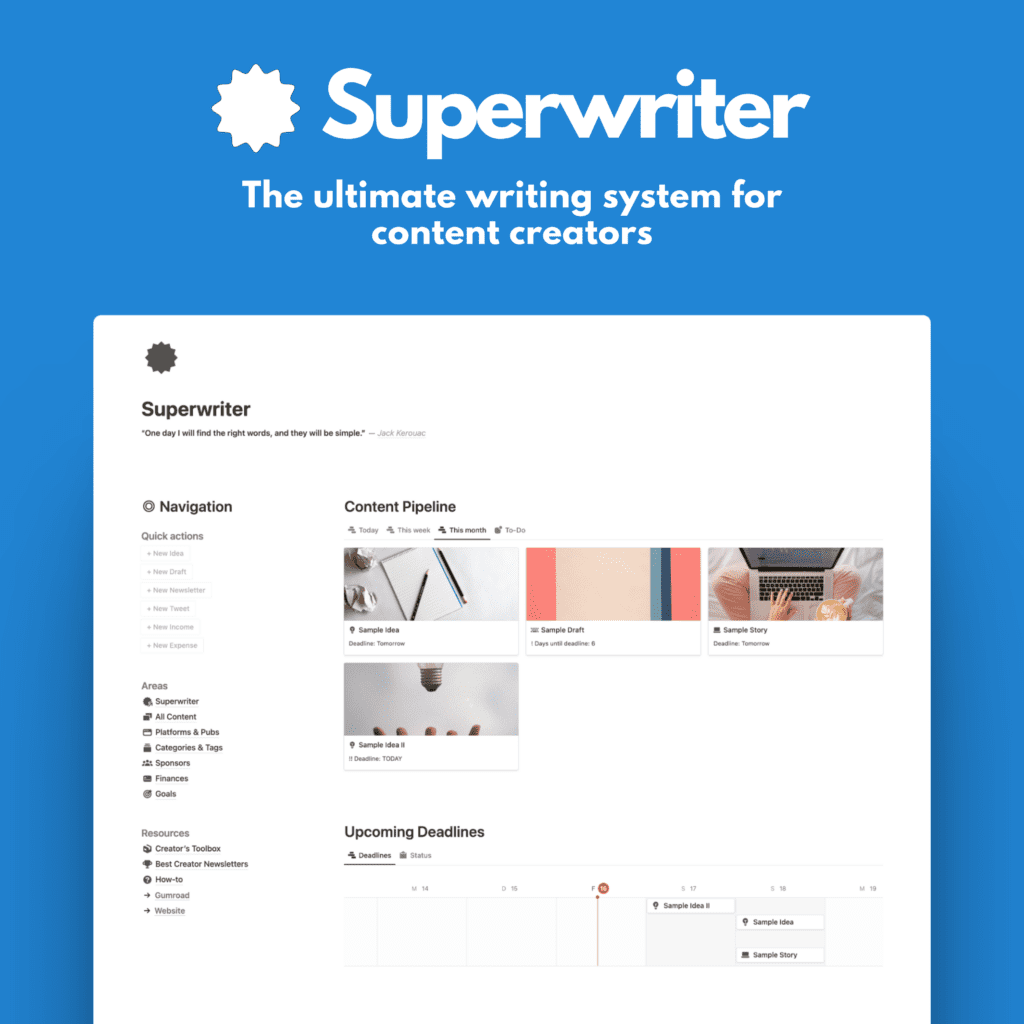So, you’ve got a Substack publications, loads of ideas, an existing story catalog in place, and all the best intentions to create a unique, appealing, and successful Substack newsletters.
But how are you going to organize your writing? What about different topics or niches, different pages, sections, and more?
Let’s see what Substack offers in terms of organizational structure for your posts and issues.
1. Starting with Sections
Segmenting Content for Targeted Delivery
Sections on Substack are a robust tool that allows you to segment your content into different categories, effectively creating sub-newsletters within your main publication.
You can then add these sections as tabs in the navigation. They will also be shown for each individual post and users can subscribe or unsubscribe to each section individually.
This feature is particularly useful if you cover a wide range of topics and want to give your readers the option to subscribe only to the content that interests them most.
How Sections Work
Sections allow you to break down your newsletter into distinct parts, each with its own content and subscriber list.
For instance, if your newsletter covers both technology and lifestyle topics, you could create separate sections for each.
Subscribers who are only interested in tech updates can choose to receive emails from that section alone, while others may prefer the lifestyle content or a mix of both.

When you create a section, you’re essentially giving your readers more control over the type of content they receive from you.
This can improve the reader experience by reducing email fatigue—subscribers won’t feel bombarded with content they aren’t interested in, which can lead to higher engagement rates and fewer unsubscribes.
Setting Up and Managing Sections
Creating a section involves some planning, as you’ll need to decide not only what content belongs in each section but also how to manage the corresponding subscriber lists.
For example, if you’re running a weekly roundup in addition to your daily posts, you might create a “Weekly Roundup” section that subscribers can opt into if they prefer a summary over daily updates.
One caveat: You can only subcategorize once with sections, meaning you can’t create subsections under one section.
Once a section is set up, you can choose to publish content directly to that section during the editing process.
Additionally, if you decide that a particular post shouldn’t be visible on your main site, you can opt to hide it from the main page, making it accessible only through the section’s mailing list.
One thing to be aware of is that sections can add a layer of complexity to your content management.
Unlike other organizational options like tags, sections are more rigid in structure. You cannot nest sections within each other.
This means you need to be deliberate in how you set up and use sections, considering your long-term content strategy and audience segmentation.
Of course, you can always remove sections, rename them, and edit them.
2. Multiple Publications:
A Broader Organizational Strategy
For some creators, a single newsletter with multiple sections might not be enough.
If your content is diverse enough or if you’re catering to different audiences, creating multiple publications could be the right move.
This strategy allows you to keep your content and subscriber lists entirely separate, offering a more focused experience for each group.
Creating niches is an important thing to consider for Substack, as readers usually prefer a connected set of topics, rather than all across the board writing.
Generally!
Why Consider Multiple Publications?
While sections allow for segmentation within a single newsletter, multiple publications take this a step further by creating entirely separate newsletters under the same Substack account.
This can be especially useful if you have distinct content streams that don’t overlap much in terms of audience.
For example, if you write about both videography and fitness, you might find that these topics attract very different readerships.
In this case, creating separate newsletters for each topic allows you to target your content more effectively.
Another advantage of multiple publications is the ability to brand each one differently.
Each publication can have its own name, logo, and theme, giving you the flexibility to tailor the aesthetic and voice to the content and audience it serves.
This can be particularly beneficial if you’re building a media brand or want to experiment with different writing styles or topics without confusing your existing audience.
Managing Multiple Publications

Managing multiple publications does require more effort, but Substack makes it relatively straightforward.
Each publication operates independently, so you can set up different subscription models, pricing tiers, and even separate email lists for each one.
This autonomy allows you to experiment with different approaches to monetization and audience engagement.
However, the downside is that you’ll need to keep track of multiple content calendars and possibly juggle different promotional strategies for each publication.
You also have separate subscriber bases.
It’s crucial to stay organized and ensure that you’re not spreading yourself too thin. If managed well, though, multiple publications can be a powerful way to grow your audience and diversify your content offerings.
3. Tags
The Flexible Tool for Content Organization
Tags are one of the most versatile and user-friendly features Substack offers for organizing your content.
They function like labels, allowing you to group related posts under specific categories.
This not only helps you stay organized but also enhances the user experience by making it easier for readers to find content on topics they care about.
How Tags Enhance User Experience
On Substack, tags act as virtual signposts that guide readers through your content.
For instance, if your newsletter includes a mix of articles on travel, food, and lifestyle, you can create tags for each of these categories.
When a reader clicks on the “Travel” tag, they’ll see all posts related to travel, regardless of when they were published.
This makes tags an invaluable tool for newsletters with a broad range of topics.
As with sections, you can add tags to your navigation bar of your Substack publication to give people quick access to the different topics.
Tags are particularly useful if you’re just starting out on Substack or if your content doesn’t require the more complex organization that sections or multiple publications offer.
They’re easy to set up, and once you’ve tagged a post, it will automatically be sorted under the relevant category on your site’s navigation bar.
Another huge bonus is that single posts can live under multiple tags, whereas a single post could only live under one section.
That makes tags far more versatile than sections.
Best Practices for Using Tags

When creating tags, think about how your readers will interact with your content.
It’s important to strike a balance between being specific enough to be helpful and broad enough to avoid an overwhelming number of tags.
For example, if you’re writing a newsletter on cooking, you might use tags like “Recipes,” “Vegan,” and “Baking” rather than overly specific tags that could dilute the categorization.
One limitation to be aware of is that tagging past posts requires manual effort (as does adding sections later on).
Unlike other platforms where you might be able to bulk-edit tags, Substack requires you to go into each post individually to apply or edit tags (a missing feature, for sure).
While this can be time-consuming, it’s worth the effort to ensure your content is well-organized and easy for readers to navigate.
Pages
Creating Custom Content Hubs
Pages are another powerful feature on Substack, offering a way to create static content that doesn’t get sent out to your email list but remains accessible on your site.
You already have a few default pages on Substack, like the About page or the Archive.
But you can create as many as you need in the settings.
Pages are ideal for showcasing information that you want to be readily available to your readers without cluttering their inboxes.
What Makes Pages Unique?
Unlike regular posts, which are included in your content feed and emailed to subscribers, pages are static and can be linked directly from your site’s navigation bar.
This makes them perfect for content that needs to be accessible at all times, such as an “About” page, a list of resources, or a “Start Here” guide for new subscribers.
Pages can also be used creatively to host content that doesn’t fit neatly into a regular post.
For example, if you’re running a promotion or offering a free download, you can create a page specifically for this purpose and link to it in your emails.
This approach keeps your main content focused while still providing value-added material to your readers.
Setting Up and Using Pages

Creating a page on Substack is similar to writing a post, but with more flexibility in how it’s presented and accessed.
You can use pages to highlight specific content, like a collection of your most popular posts or a curated list of resources that complement your newsletter’s theme.
One useful application of pages is to create a “Products” page if you’re selling digital products like eBooks, courses, or merchandise.
This page can be styled to your liking and doesn’t clutter your main newsletter feed.
You can then reference this page in your newsletter’s navigation bar, footer, or within posts to drive traffic to your products without overwhelming your subscribers.
Pages can be added or removed from your site’s navigation bar at any time, giving you the flexibility to update or refresh your content as needed.
Unlike tags, pages don’t require you to manage a long list of categories, making them a straightforward way to present important but non-time-sensitive information.
The Bottom Line
Deciding how to organize your content on Substack is all about understanding your setup and outlook.
Sections provide a way to segment your content into focused streams, ideal for delivering targeted content to specific groups of subscribers.
If your content is diverse enough, consider creating multiple publications to keep each newsletter focused and your audiences separate.
Tags offer a simple and effective way to categorize your posts, making it easy for readers to find content that interests them, while pages allow you to create static content hubs for additional resources, promotions, or important information.
Of course, you can also combine multiple of these organizational structure (and you probably should) to make your newsletter and site as user-friendly, navigable, and successfull as possible.








